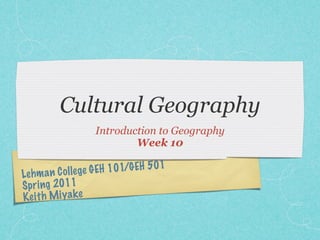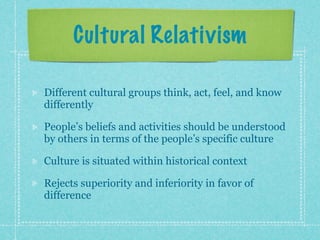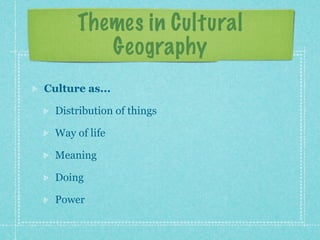Ch7 cultural geography
- 1. Lehman College GEH 101/GEH 501 Spring 2011 Keith Miyake Cultural Geography Introduction to Geography Week 10
- 2. Definitions of Culture Cultivated behavior; learned and accumulated experience that is socially transmitted Systems of knowledge shared by group of people Communicated behaviors, beliefs, values, symbols Products of action, conditioning for future action
- 4. Cultural Determinism Culture determines human nature People are what they have been conditioned to be, over which they have no control Culture of poverty: Moynihan Report “at the heart of the deterioration of the fabric of Negro society is the deterioration of the Negro family. It is the fundamental source of the weakness of the Negro community at the present time.”
- 5. Cultural Relativism Different cultural groups think, act, feel, and know differently People’s beliefs and activities should be understood by others in terms of the people’s specific culture Culture is situated within historical context Rejects superiority and inferiority in favor of difference
- 6. Cultural Ethnocentrism Belief that one’s own culture (or group identity based on cultural characteristics) is superior to others View other cultures in terms of one’s own Nationalism/xenophobia Colonialism White supremacy
- 7. Break Sign in Term paper questions? Term paper due date... Outlines
- 8. Themes in Cultural Geography Culture as... Distribution of things Way of life Meaning Doing Power
- 9. Cultural Artifacts The material things that express culture All people produce cultural artifacts Everyday items: furniture, clothes Large structures: buildings, cities How to understand relationship between these artifacts and the values, livelihoods, beliefs, and identities of cultures that produce them? What can the pattern of material artifacts tell us about the social, economic and political dynamics of cultures?
- 10. Cultural Geographies are as much about the graffiti themselves as they are about the locations of the graffiti-marked buildings; as much about the idea of home as they are about the distribution of housing; and as much about the diversity within culture as they are about cultures per se. These geographies ask why and how, as much as where and when. Source: http://lapd.com/news/headlines/tagging_or_just_hanging_out_--_busted_either_way/
- 11. Culture as a Way of Life The values, beliefs, languages, meanings and practices that make up people’s ‘ways of life’ Rural/Urban, Relaxed/Fast-paced Religious beliefs and traditions Expressions of identity ethnicity, gender, sexuality, age, ability, occupation, etc. Different ways of life structure the daily practices and individuals in different places
- 13. Culture as Meaning How and why landscapes become embedded with individual and cultural meaning and in turn create new meanings Meaning: individual emotions, experiences and memories group values, attachments and ideals Whose meanings are given precedence in these interpretations? Cultural hegemony and assimilation Meaning is connected to place; value ascribed to places
- 14. Interpreting ‘Ordinary’ landscapes – places that we often take for granted in our everyday life, like our homes and towns – requires in-depth, often intimate, knowledge of local history, cultural values and economic structures. Source: http://www.flickr.com/photos/ethanbee/2428883258/
- 15. Symbolic landscapes – places that are imbued with special meaning beyond the everyday civic pride, national identity and global circulation urban and national political agendas, constructions of local and national identity, and the global market of image circulation Source: http://madhadder.blogspot.com/2010/09/ten-years-ago-todayas-if-it-were.html
- 16. Culture as Doing Living of everyday life Performing, learning, resisting, moving Culture affects actions and actions affect culture Places shape cultures and cultures shape places What does this mean geographically?
- 17. Culture as Power How artifacts get made, how they get from one place to another, and who benefits from all this trading and placing Power to do things Power relations organized around politics, gender, lifestyle, race, ethnicity, sexuality, nationality, etc. Sites of oppression and resistance, the different scales through which power relations operate and how space is manipulated by the powerful and the weak
- 18. Components of Culture Culture trait - Single distinguishing feature of a culture Culture complex - Group of culture traits that are functionally interrelated Culture system - Shared, identifying traits uniting two or more culture complexes Culture region - Portion of the earth’s surface in which common cultural characteristics prevail Culture realm - Collective of culture regions sharing related culture systems
- 19. Human-Environment Interactions Cultural ecology: Study of the relationship between a culture group and the natural environment it occupies Human Impacts Cultural landscape: The earth’s surface as modified by human action Relationship between technological advancement and impact on the environment
- 21. Human-Environment Interactions and Ideology Historical Materialism (Marx): technological change drives historical progress technology increases human control over the environment technology drives society’s economic system economic system determines political and social life technology has the potential to be revolutionary if it can undo uneven economic and social systems by improving material conditions (overall wealth)
- 22. Human-Environment Interactions and Ideology Environmental Determinism: belief that the physical environment explains human cultures and behaviors Possibilism: physical environment neither suggests nor determines what people will attempt, but it may limit what people can profitably achieve Choices and constraints are as much cultural, economic, political, and social as they are technological; e.g. growing crops in a greenhouse versus importing them
- 23. Cultural Change Technological, Sociological, Ideological Subsystems Change through Innovation Change through Spatial diffusion Change through Acculturation
- 24. Structure of Feeling How are places structured through cultural practices? Role of Language Role of Religion Role of Ethnicity Role of Gender In terms of... Distribution of things Way of life Meaning Doing Power























